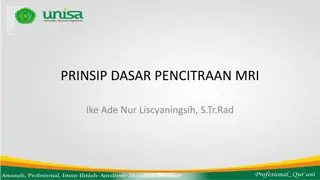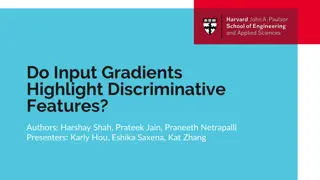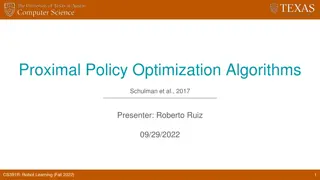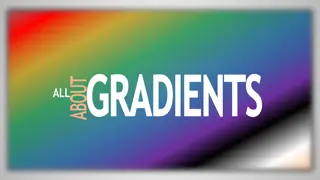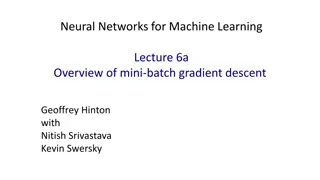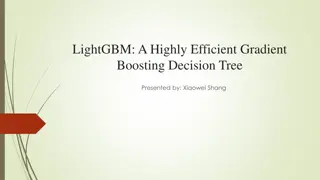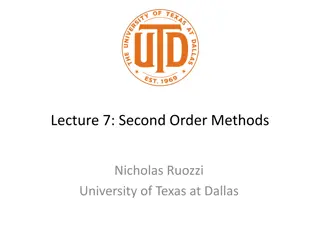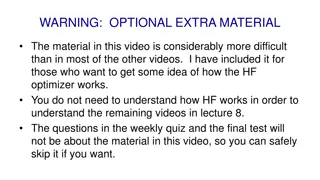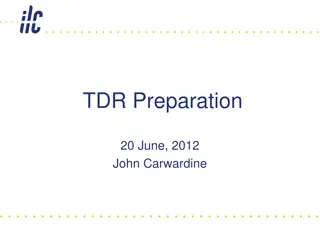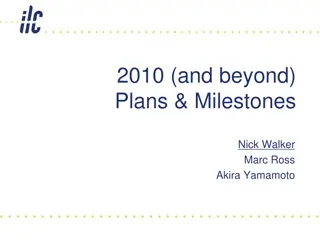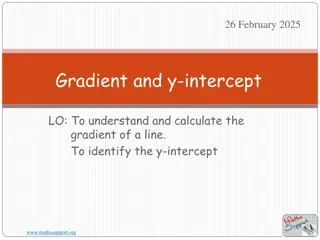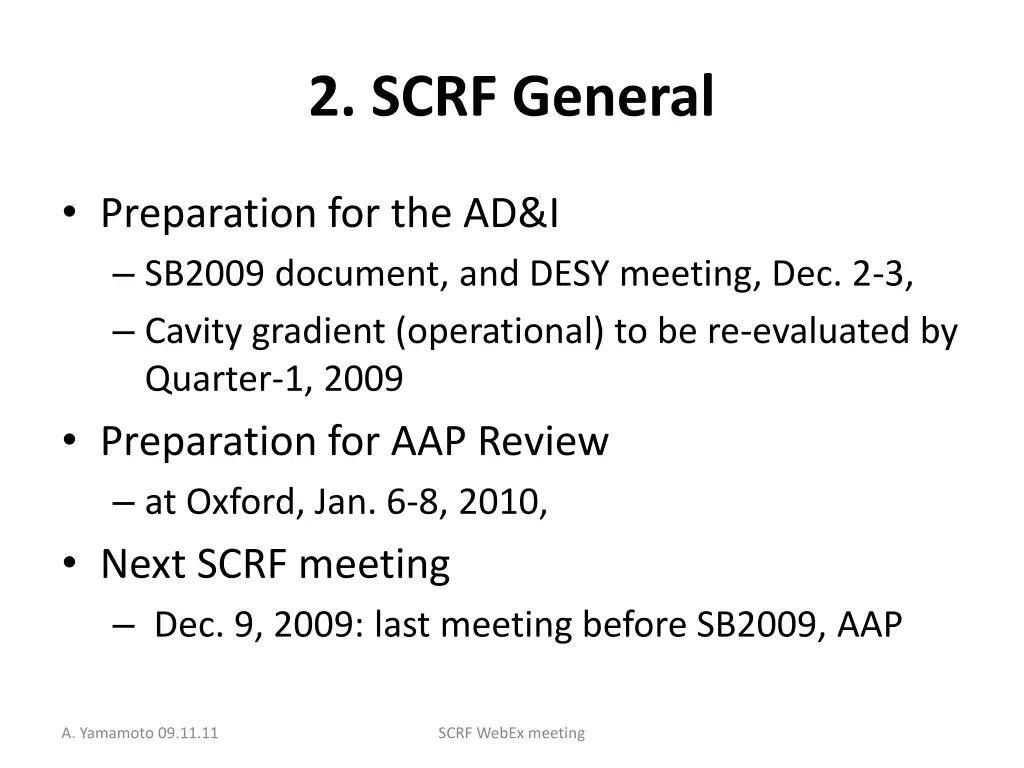
Cavity Gradient and Production Yield Analysis for Particle Accelerator Development
Explore the latest updates on cavity gradient re-evaluation, production yield statistics, and global R&D efforts in the field of superconducting radiofrequency technology. Discover insights from SCRF meetings, test results, and prospects for advancing particle accelerator technologies.
Download Presentation

Please find below an Image/Link to download the presentation.
The content on the website is provided AS IS for your information and personal use only. It may not be sold, licensed, or shared on other websites without obtaining consent from the author. If you encounter any issues during the download, it is possible that the publisher has removed the file from their server.
You are allowed to download the files provided on this website for personal or commercial use, subject to the condition that they are used lawfully. All files are the property of their respective owners.
The content on the website is provided AS IS for your information and personal use only. It may not be sold, licensed, or shared on other websites without obtaining consent from the author.
E N D
Presentation Transcript
2. SCRF General Preparation for the AD&I SB2009 document, and DESY meeting, Dec. 2-3, Cavity gradient (operational) to be re-evaluated by Quarter-1, 2009 Preparation for AAP Review at Oxford, Jan. 6-8, 2010, Next SCRF meeting Dec. 9, 2009: last meeting before SB2009, AAP A. Yamamoto 09.11.11 SCRF WebEx meeting
Global Plan for SCRF R&D Year 07 2008 2009 2010 2011 2012 TDP-1 TDP-2 Phase Cavity Gradient in v. test to reach 35 MV/m Yield 50% Yield 90% Global effort for string assembly and test (DESY, FNAL, INFN, KEK) FLASH (DESY) , NML (FNAL) STF2 (KEK, extend beyond 2012) Production Technology Cavity-string to reach 31.5 MV/m, with one- cryomodule System Test with beam acceleration Preparation for Industrialization R&D A. Yamamoto 09.11.11 SCRF WebEx meeting
New Production Yield after 1stand 2ndPass (RF) Test Electropolished 9-cell cavities Yield at 35 MV/m: 22 % at 1stpass 33 % at up to 2ndpass JLab/DESY (combined) first successful test of cavities from qualified vendors - ACCEL+ZANON (22 cavities) 100 1stpass 90 80 70 Electropolished 9-cell Cavities 60 yield [%] 50 combined upto-second-pass test of cavities from qualified vendors - ACCEL+ZANON (21 cavities) 40 100 30 90 20 80 10 70 2ndpass 0 60 yield [%] >10 >15 >20 max gradient [MV/m] >25 >30 >35 >40 50 40 1 5 improvement 30 1 0 20 5 10 0 0 1 2 3 4 5 6 7 8 9 1 0 1 1 1 2 1 3 1 4 1 5 1 6 1 7 1 8 1 9 2 21 >10 >15 >20 max gradient [MV/m] >25 >30 >35 >40 -5 degradation D D -1 0 ILC Operation at <31.5 MV/m> Yield reaching ~ 40 % -1 5 cavity Reported by C. Ginsburg and GDB team A. Yamamoto 09.11.11 SCRF WebEx meeting
Alternate Yield Plot July 2009 Data 1st +2nd Pass, 1st pass cut 35MV/m ,Accel or Zanon Alternative Yield Analysis Electropolished 9-cell Cavities combined upto-second-pass test of cavities from qualified vendors - ACCEL+ZANON (21 cavities) 45.0 100 90 80 40.0 70 60 yield [%] 50 35.0 40 30 Gradient MV/m 20 30.0 10 0 >10 >15 >20 max gradient [MV/m] >25 >30 >35 >40 25.0 Average Gradient max 20.0 15.0 10.0 5.0 0.0 0% 20% 40% 60% 80% 100% Yield Yield is estimated assuming a specific lower cut-off in cavity performance, below which cavities are assumed 'rejected . Error bar is +/- one RMS value (standard deviation of the population) of the remaining (accepted) cavities (gradient above cut-off). Additional bars (min, max) inidcated the minimum and maximum gradients in the remaining (accepted) cavities. A. Yamamoto 09.11.11 SCRF WebEx meeting
Progress and Prospect of Cavity Gradient Yield Statistics PAC-09 Last/Best 2009-05 9 (AC) 16 (ZA) FALC 1stPass 2009-07 8 (AC) 7 (ZA) ALCPG 2nd Pass 2009-10 14 (AC/ZA) To be added (2009-11) 10 (Prod- 4) Coming Prod. Y. (2010-06) 5 Research cavities 8 (large G.) DESY JLAB FNAL/A NL/Corn ell 8 (AC) 4 (AE) 1 (KE-LL5) 1 (JL-2) 7 (AC) 7 (AC) ~ 5 (AE) 12 (AC) 6 (AE) 6 (NW) (including large-G) ~5 (LL) 1 (IHEP) ~ 20 KEK/IH EP Sum 5 (MH) 2 (MH) 39 22 21 20 25 41 66 G-Sum Statistics for Production Yield in Progress to reach > 60, within TDP-1. We may need to have separate statistics for production and for research , A. Yamamoto 09.11.11 SCRF WebEx meeting
Cavity Gradient Study - Status Yield at 35 MV/m (w/ established vendors: RI, Zanon) 22 % at 1stpass (statistics 22) 33 % at 2ndpass (statistics 21, as of 2009-07)) Average Gradient reaching 30 MV/m DESY Prod-4 data to be added, (10 more statistics) New statistics coming (w/ potential vendors) AES: to be counted from #5 (to be confirmed) MHI: to be counted from #5 (to be confirmed) Selecting statistics needed for Production Yield to evaluate readiness of industrialization and cost Note: Numbers of Cavities for gradient research : need to be separately counted. A. Yamamoto 09.11.11 SCRF WebEx meeting
AES-JLAB/FNAL Progress Reported by R. Geng A. Yamamoto 09.11.11 SCRF WebEx meeting
Achievement with Contribution of basic R&D for surface conditions Possible reasons for improvement: Water rinsing (increased flow rate, time) Detergent rinsing EP solution condition (aged) A. Yamamoto 09.11.11 SCRF WebEx meeting
S1 Goal: Achieved at DESY/XFEL Average field gradient at CMTB : > 31.5 MV/m - First XFEL prototype module exceeds 31.5 MV/m average - Module will see beam in FLASH in 2010 (av. of 30MV/m) - Cryostat (cryomodule cold-mass) contributed by IHEP A. Yamamoto 09.11.11 SCRF WebEx meeting
A Proposal for Re-baseline Cavity Gradient and Yield, in TDP-2 S0: Maximum gradient of 35 MV/m (@ Q0 = 8E9) in vert. test Keep R&D goal: yield of 90 % at 35 MV/m, and Recognize that the yield may be acceptable to be ~ 50 % with the +/-20 % distribution (i. e., b/w 28 and 42 MV/m) of the gradient. S1: Cavity-string: E = <31.5 MV/m> (@ Q0 = 1E10) in cryomodule Keep the averaged field gradient in cryomodule string, and Recognize Acceptable gradient spread of ~ 20 % in operation See the recent progress at DESY PXFEL cryomodule test result S2: Cryomodule string w/ RF operationability Need to re-evaluate the level of operational margin to be required in accelerator beam operation, It may need to take into account to determine the ILC operational field gradient, (>> we need to discuss it) A. Yamamoto 09.11.11 SCRF WebEx meeting

